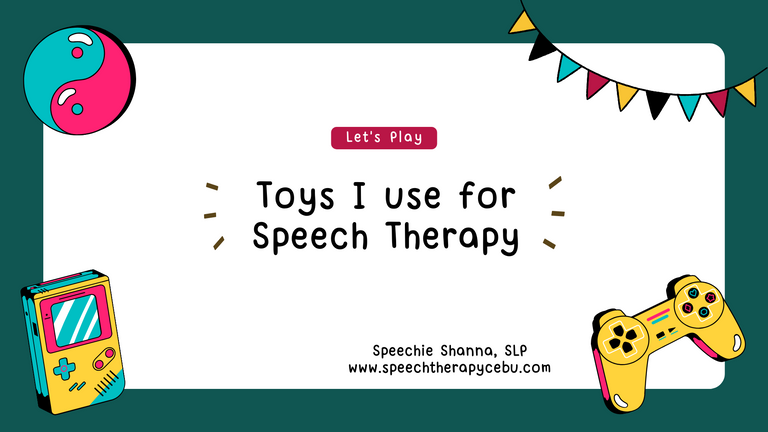
Hi everyone! Wearing my speech therapist hat for this blog. 🎩
I will be showing you the different toys that I usually use during speech therapy and how we can use them to target speech and language goals.
First of all, let's define SPEECH vs LANGUAGE. These two terms are necessary for communication.
SPEECH means the sounds we produce when talking, the smoothness or fluency of our speech, and the use of our voice. The kids that I see for speech therapy with speech disorders can have trouble saying the sounds or putting sounds together to make a word, or they stutter when talking or they use an inappropriate voice according to their age or gender.
LANGUAGE, on the other hand, means the use of symbols to make meaningful interactions with others such as expressing our ideas, engaging in conversations, and understanding what other people say. The bulk of my caseload is autistic kids and they present delays in their language development. This means that they can have trouble understanding questions, difficulty reading/writing or putting words together to make a sentence.
For each of the toys, I will show you examples or goals we can target for their SPEECH and LANGUAGE skills.

TOYS ANIMALS
Kids love toy animals because it allows them to engage in imaginative play, it is sung in nursery rhymes, it helps them explore nature and the animal kingdom, and it stimulates learning as they discover the different characteristics of animals.
SPEECH:
For speech or articulation, we first identify the specific sounds that the child has to practice - for example, the "k" sound which can be heard from words with K and C. We can use animal names (Kangaroo, Koala, Cow), animal sounds (quack, coo), action words associated with animals (kangaroo can kick, keep the cat), or adjectives to describe the animals (cute, kind, scary). This can be done by letting them answer questions (What is this animal?) or imitating how you say it (Listen and repeat after me.)
LANGUAGE:
For language, we play with toy animals to help them expand their vocabulary such as learning their names, where they live (ocean, farm, jungle), and their characteristics (big, run fast, furry) which is also done by answering WH-questions (Who, what, where). We can also help them follow commands by teaching spatial concepts (Put the cow in the truck, bring them all down) or movements (Run like a cheetah.). We can also make stories about the animals that can help them learn how to sequence events (First, the truck went to the farm. Next, the animals went in. Last, they will go on a trip.).
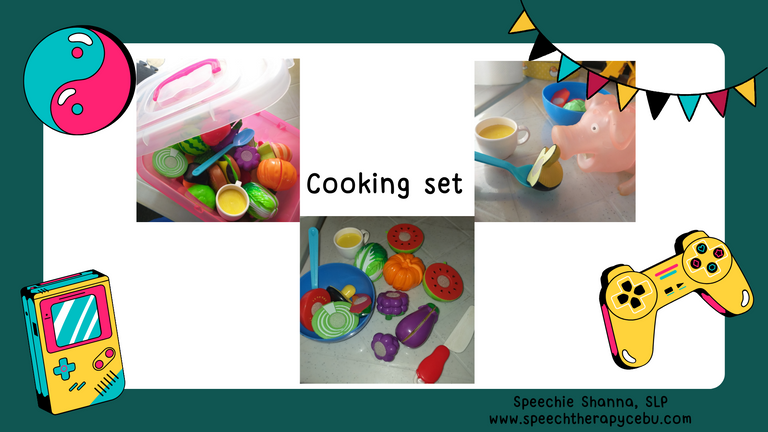
COOKING SET
One of my favorite playsets is the cooking set that includes velcro-attached food, allowing children to engage in pretend slicing and cooking activities. Children are interested in toys that could trigger a response when they interact with them. This helps them understand the cause-effect relationship and develop problem-solving.
SPEECH:
This goes the same with toy animals, it's just that the theme is cooking. We use the names of food, cooking tools, and action words to target the speech sounds. Example: When targeting the R sound, we can teach them to say "rice", "radish", "red tomato", "roast the chicken", or "get the rolling pin".
LANGUAGE:
Cooking is an activity that children see at home almost every day. We can teach the names of the food and their categories (fruits, vegetables, meat) especially those that they usually see in their fridge or the food they like to eat. We can teach them how to form sentences by describing what we're doing (I am cooking chicken. The oven is hot.). We can also practice social skills by taking turns, requesting or asking for help, and giving instructions during the cooking activity.
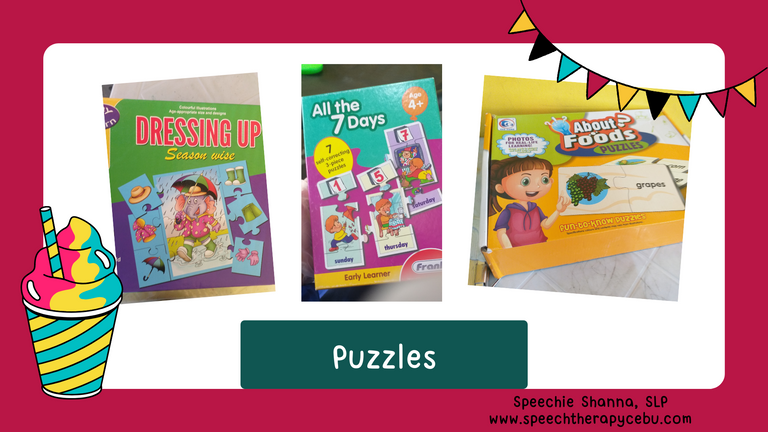
PUZZLES
Puzzles
A puzzle is a versatile tool that can enhance cognitive, fine motor, language, spatial awareness, and social skills. It is important to choose puzzles appropriate to their age or ability and goals.
SPEECH:
It is important to consider what puzzle to present the child when working on their speech. We need to choose puzzles that have words that can target the specific sounds they are working on. We help them practice the sounds as they complete the puzzle. Another way to use the puzzle is to give them a piece after imitating a target sound from our word list.
LANGUAGE:
As children engage with puzzles, they learn to analyze, plan, and manipulate pieces to complete the picture. We can teach them to voice out how they solved the puzzle to create conversations and to use their words or sentences ("I think I need to put this here." "Uh oh, it doesn't fit." "Can you help me find the blue puzzle."). Puzzles can teach them various concepts, and some examples in the picture are days of the week, food picture-word matching, and clothing according to the weather.
Behind the scenes:
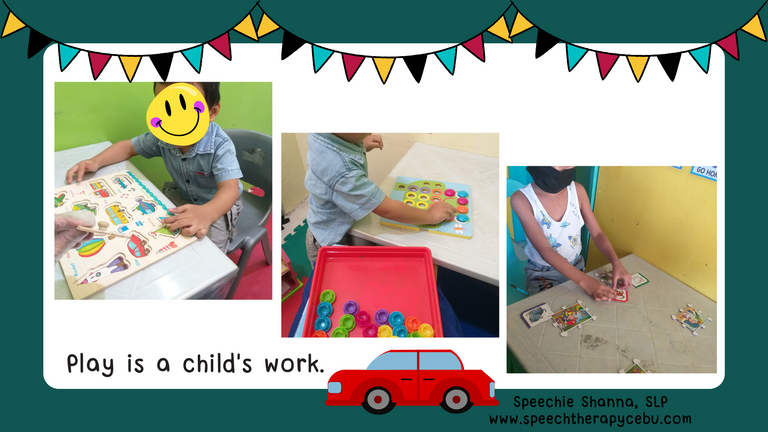
Some things to keep in mind when playing with kids:
- It is important to keep the activity safe, fun and engaging.
- Allow the child to make mistakes and not to correct them immediately.
- Make sure to relate what they learned during play to real situations. For example, if they learned about the different categories of food during the pretend cooking activity, let them help sort your groceries (where the fruits or vegetables should be placed) in the kitchen.
- Provide praise and encouraging words to keep them motivated and build confidence.
- Have fun and enjoy the moment with the child and make it a memorable experience for them!
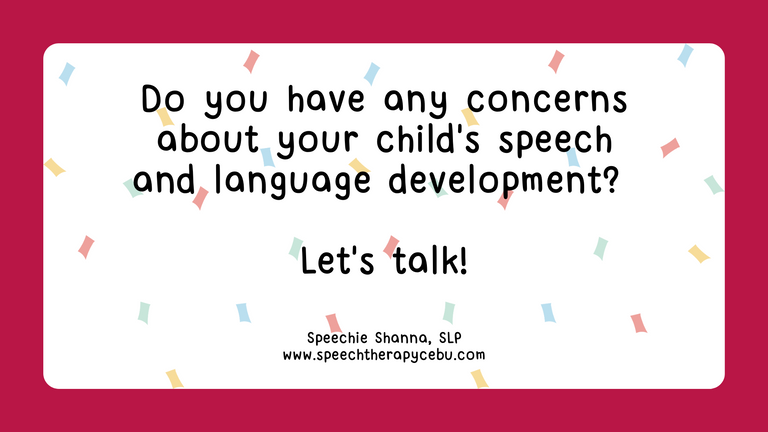

Welcome to Chill with Shanna. Shanna is a life enthusiast and a wanderer. She is easygoing, and spontaneous, and wants to challenge herself by testing her limits. She aspires to be an effective storyteller and content creator. She is in pursuit of fulfilling her purpose, living a good life, and ticking adventures off her bucket list.
She is a Speech-Language Pathologist and AXA Financial Advisor by profession. If you like to hear her stories and experiences, please upvote, follow and leave a comment. It will be much appreciated. 😊
Great post!
The toys are exactly the same as my wife and I use in our OT clinic!
All kids absolutely love animals...and dinosaurs too, regardless of gender and its a superb way to get them speaking and repeating.
Do you use phonic based language learning such as Jolly Phonics? and I'd be really interested in your advice on how to help kids struggling to differentiate ch and sh sounds.
I also ought to post more about helping people with kids who have LD, ASDs, ADHD and global developmental issues and you should expect a knock on your blog when we have difficult speech cases we're struggling with.
Best wishes and thank-you :-)
Hello there! Are you an occupational therapist and where are you based? Looking forward to learning from you too! I'm sure this can benefit the parents or planning to be here on hive.😊
For the ch and sh sounds, I use gestural cues (sh- putting my finger to my lips for "be quiet" and ch- holding an imaginary spray) and verbal cues (sh- quiet sound, it is a long sound and ch- spraying sound like you're spraying water on the plant, it is quick and short). We practice imitating and saying it together then I present it using minimal pairs.
I used the Twinkl phonics for my classes since I purchased membership and they have tons of other language activities. I haven't explored Jolly phonics.
Thanks for the advice! I'm not an OT, my wife is and we have a clinic in Koh Samui, Thailand. I am the assistant. The cleaner. The guy who makes sure there are plenty of tissues handy! I also teach a little English and Maths, mostly to kids with special needs :-)
Very good, excellent and simple explanation, it is very important to support the development of children's linguistic skills, sometimes they are not given the proper value to each of the skills and abilities from the acquisition of vocabulary, grammatical structures and the production of sounds. Your explanation of the toys is wonderful. Congratulations
Hello! nice to meet you here! Thank you so much!
This is very helpful for hands-on parents at home.
♥️♥️ thank you!!
Ang dami kong natutunan about sa speech vs language at kung paano gamitin ang toys for speech and language therapy. Keep sharing your knowledge! @chillwithshanna
Napili po namin ang post na ito sa aming curation ng MCGI Cares Hive community. Nais po namin kayo na anyayahan sa aming community na nag aaral ng salita ng Dios. Maaari rin po natin i-follow ang aming Official Youtube channel. Keep doing the great job po ❤️
Salamat po for taking time to read my post. Hope mainform nyo din po yung mga may anak 😊
Congratulations @chillwithshanna! You have completed the following achievement on the Hive blockchain And have been rewarded with New badge(s)
Your next target is to reach 600 comments.
You can view your badges on your board and compare yourself to others in the Ranking
If you no longer want to receive notifications, reply to this comment with the word
STOPTo support your work, I also upvoted your post!
Check out our last posts: